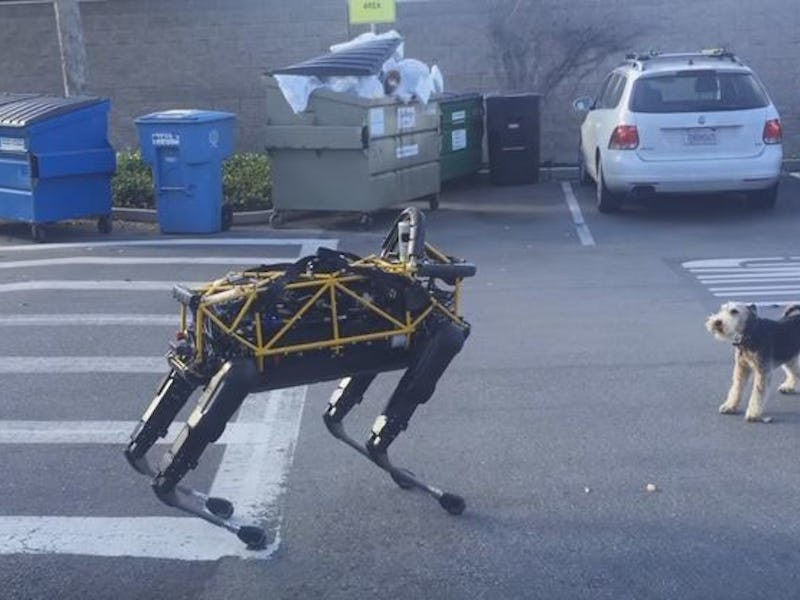Dog vs. Robot Dog Video Offers a Glimpse of the Uncanny Canine Valley
The Sophie’s choice of the future is our pets or our robo-dogs.

It plays out like a scene from any dog park or sidewalk across the country: A small pooch spies a larger four-legged beast, and canine hell breaks loose. The pup crouches forward, a proper downward-facing dog. He sounds his barbaric yip. The larger one prances in place, and more or less ignores this new acquaintance.
In this case, though, the bigger creature isn’t a Rottweiler but a robot, the only four-legged Boston Dynamics machine out in the civilian wilds. And the dog vs. bot showdown, filmed and put on YouTube, is destined for viral Valhalla:
The Google-owned Boston Dynamics has been on a bit of a YouTube tear, recently showing off its humanoid Atlas robot navigating a forest with surprising dexterity. This new flick, however, isn’t as charming as our Jetsons fantasies would have it.
“I’m afraid the dog looks simply alert and possibly alarmed to me, but not at all playful,” Alexandra Horowitz, a dog cognition expert at Barnard College in New York, tells Inverse. “Indeed, it is just how I would expect a dog to react to an entirely novel stimulus.”
Rachel Orritt, who studies dog aggression at the University of Lincoln, U.K., agrees. “From observing the dog’s behavior, it is not engaging in typical dog-dog play,” she says. “The stiff, upright stance of the dog, high, stiff tail movements and the type of bark show that the dog is not comfortable with the robot.”
Dogs, like humans, communicate in part through body language. “You’ll notice the only time the dog gets close to the robot is when the robot is moving away from the dog,” Orritt says. “The dog is not comfortable approaching the robot at any other time, indicating that the dog regards the robot as a potential threat.” If the dog in the video seems as though it can’t make up its mind to stay close to the quadrupedal droid or run away, that could be a sign of what veterinarians call ambivalent behavior — a paralyzing middle ground between aggression and fear.
And, like humans, canine vocalizations indicate friendly or aggressive dispositions. “The pup doesn’t show any play signals as though to initiate play,” Horowitz says. “His bark is not a play bark.”
YouTube poster “jurvetson” offers up the encounter as an example of “the uncanny uncanine valley.” (The uncanny valley in humans attempts to explain the unsettling feeling of observing a Stepford robot or plasticized Tom Hanks avatar. It’s too close to human for comfort. Robots that don’t attempt to carbon-copy humans — your Artoos and Threepios — aren’t as alarming.) “It is not possible to know for certain if the dog is regarding the robot as an animal or as a ‘mysterious other’,” as Orritt puts it.
Should robots replace human dog walkers or share a household with a pooch, perhaps they’ll have to take the form of something neutral — something that doesn’t seem so confusingly canine. Cats have conquered the decidedly-unfeline Roomba, after all.
This post has been updated to include comments from University of Lincoln’s Rachel Orritt.